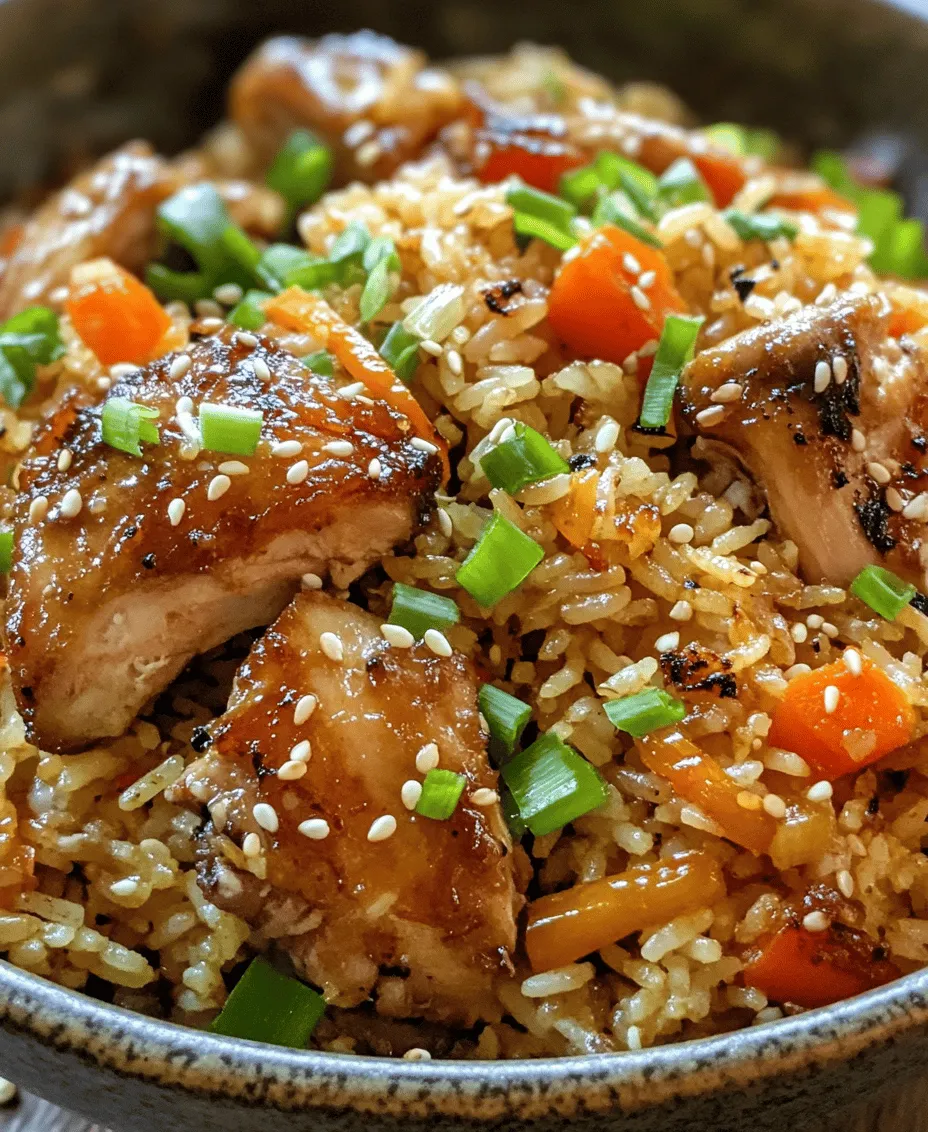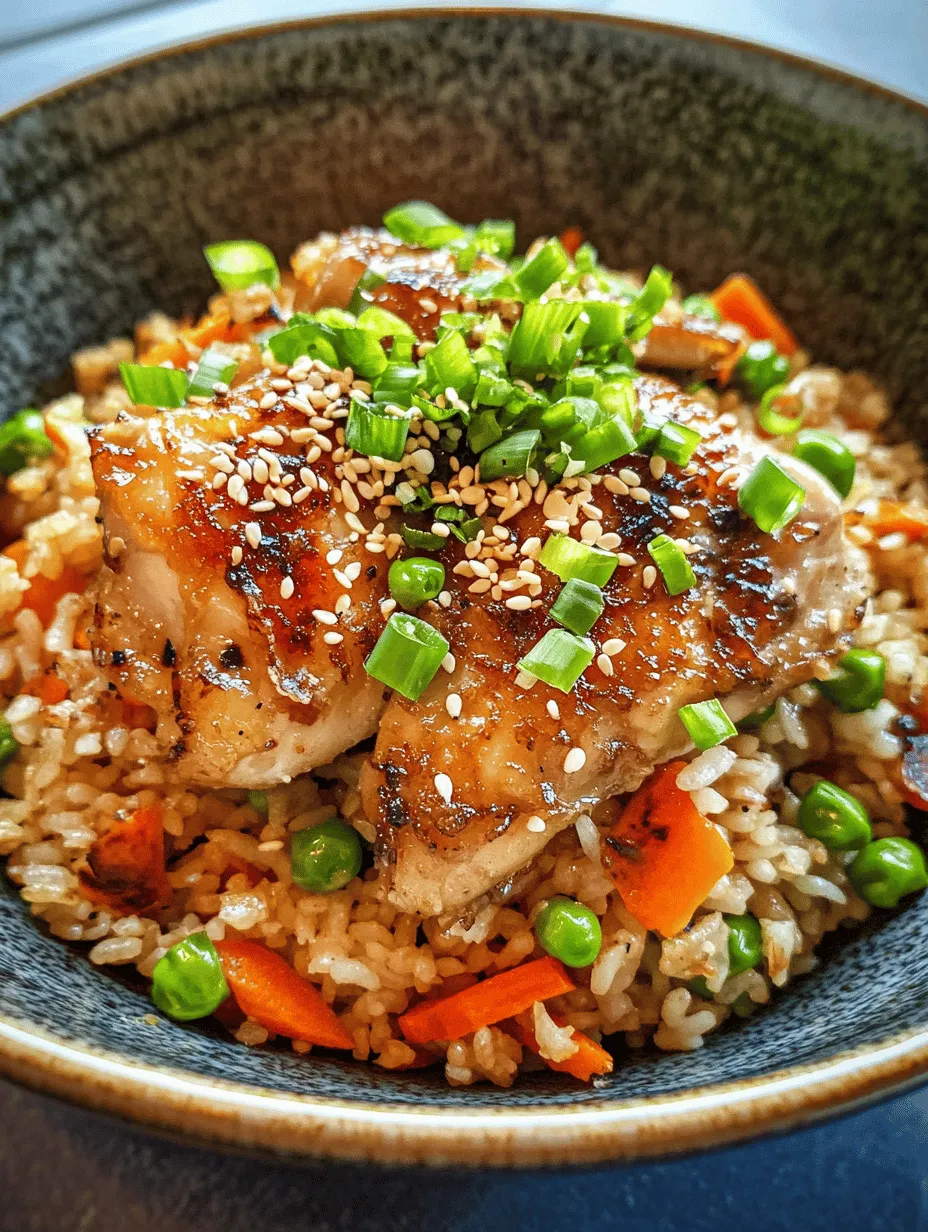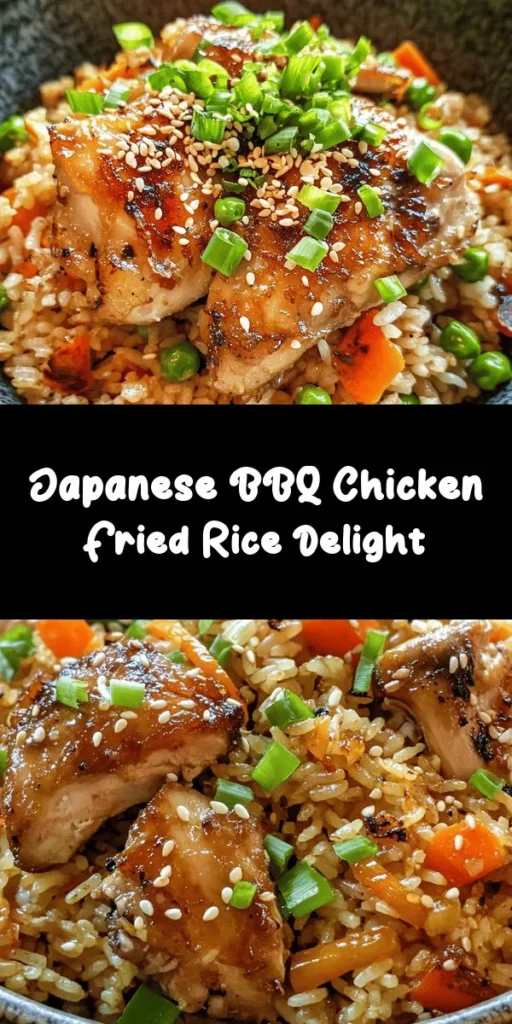Introduction
Fried rice is a beloved staple across various Asian cuisines, celebrated for its versatility and comforting nature. Originating from China, this dish has been adapted and embraced by cultures worldwide, each adding unique flavors and techniques. In Japan, fried rice, or “chahan,” often includes local ingredients and seasonings that highlight the country’s culinary traditions. Today, we’re excited to introduce a delightful twist on this classic dish—Savory Japanese BBQ Chicken Fried Rice Extravaganza.
This recipe is a fusion of rich Japanese BBQ flavors, seamlessly integrated into the warm, fried rice we all know and love. Imagine tender, marinated chicken thighs infused with the sweetness of teriyaki sauce, combined with perfectly cooked rice, fresh vegetables, and a hint of sesame oil. This dish is not just a meal; it’s an experience that brings comfort and satisfaction to your dinner table.
Whether you’re seeking a quick weeknight dinner, a family-friendly meal, or a hearty option for meal prep, this recipe checks all the boxes. With its colorful presentation and mouthwatering taste, it is sure to become a favorite in your household. Let’s dive into the details of the ingredients that make this dish so special and prepare for a culinary adventure that will tantalize your taste buds.
Understanding the Ingredients
To create the perfect Savory Japanese BBQ Chicken Fried Rice, understanding each ingredient’s role is crucial. Here’s a detailed look at what you’ll need:
Jasmine Rice
The foundation of any great fried rice is the rice itself, and for this recipe, jasmine rice is the star. Known for its delicate floral aroma and slightly sticky texture, jasmine rice is excellent for fried rice because it holds up well without becoming mushy. For optimal results, it’s best to use day-old jasmine rice. Why? Freshly cooked rice tends to be moist, which can lead to clumping when fried. Day-old rice, on the other hand, has dried out slightly, allowing for better separation of grains during cooking. This results in a beautifully textured fried rice that has a perfect bite.
Boneless Skinless Chicken Thighs
While many recipes call for chicken breast, we recommend using boneless, skinless chicken thighs for this dish. Thighs are more flavorful and tender, making them an ideal choice for marinating and frying. Their higher fat content helps keep the meat juicy and prevents it from drying out during cooking. When marinated in a savory BBQ sauce, chicken thighs absorb flavors beautifully, enhancing the overall taste of the fried rice.
Soy Sauce and Teriyaki Sauce
These two sauces are essential for achieving the signature umami flavor in our fried rice. Soy sauce is a staple in Japanese cuisine, contributing a salty, savory depth that enhances the dish. Teriyaki sauce, with its sweet and tangy profile, complements the soy sauce and adds a layer of complexity. Together, they create a harmonious balance of flavors that elevates the chicken and the rice. Adjust the quantities according to your taste preferences, ensuring the dish is well-seasoned without overpowering the other ingredients.
Sesame Oil
Sesame oil plays a critical role in this recipe, infusing the fried rice with its distinct aroma and flavor. This oil is rich in antioxidants and adds a nutty essence that enhances the overall dish. A little goes a long way, so be sure to use it sparingly to avoid overwhelming the other flavors. It’s best added toward the end of the cooking process to preserve its rich, fragrant qualities.
Fresh Vegetables
Incorporating fresh vegetables not only adds nutritional value but also contributes vibrant colors and textures to the dish. Common choices for fried rice include bell peppers, green onions, peas, and carrots. These vegetables provide essential vitamins and minerals while enhancing the overall flavor profile. Feel free to mix and match according to your preferences or what you have on hand. The goal is to create a colorful and nutritious medley that complements the rich flavors of the chicken and sauces.
Eggs
Eggs are a classic addition to fried rice, providing an extra boost of protein and richness. They also enhance the dish’s texture, creating a creamy consistency that ties all the ingredients together. For this recipe, we recommend lightly scrambling the eggs before adding them to the fried rice, ensuring they blend seamlessly with the other components. This step not only adds flavor but also makes the dish more filling.
Preparation Steps
Now that we’ve covered the essential ingredients, let’s move on to the preparation steps that will set you up for success in making this savory dish.
Marination Process
Marinating the chicken is a crucial step in infusing flavor into the meat. For this recipe, combine soy sauce, teriyaki sauce, and a splash of sesame oil in a bowl. Cut the boneless skinless chicken thighs into bite-sized pieces and add them to the marinade. Allow the chicken to marinate for at least 30 minutes; however, if you have the time, letting it sit for a few hours or even overnight in the refrigerator will intensify the flavors even further.
Feel free to experiment with variations in your marinade. For a spicy kick, consider adding a teaspoon of sriracha or a sprinkle of red pepper flakes. The key is to ensure that the chicken is well-coated and allowed to absorb the flavors, elevating the taste of the final dish.
Rice Preparation
If you’re using day-old rice, you’re already ahead of the game. If you need to cook fresh jasmine rice, follow these steps: Rinse the rice under cold water until the water runs clear to remove excess starch. This step is vital for preventing mushiness. Cook the rice according to package instructions, but consider reducing the water slightly to ensure it’s not overly wet. Once cooked, spread the rice onto a baking sheet to cool quickly, which helps prevent clumping. If you have time, let it sit uncovered in the refrigerator for at least 30 minutes.
If you’re in a rush and need to cool fresh rice, you can spread it thinly on a tray and place it in front of a fan for a few minutes. Just be mindful not to cool it too much—warm rice is ideal for frying, as it helps create that perfect crispy texture.
Cooking Techniques
The choice of cooking equipment can significantly impact the outcome of your fried rice. A large skillet or a wok can be used for this recipe; however, a wok is preferred due to its high, sloping sides and ability to distribute heat evenly. When using a wok, heat it over medium-high heat until it’s fully hot before adding oil. This high heat is essential for achieving a golden-brown sear on the chicken and vegetables while ensuring the rice gets that coveted charred flavor.
Once the wok is hot, add a tablespoon of vegetable oil and allow it to heat until shimmering. The key here is to keep the heat high throughout the cooking process, allowing each ingredient to cook quickly and evenly without steaming. This method is especially important for browning the chicken, which adds additional flavor to the dish.
Cooking the Savory Fried Rice
Now that you have your ingredients prepped and your cooking equipment ready, it’s time to start cooking! Here’s a step-by-step breakdown of the process:
1. Cook the Chicken: Add the marinated chicken thighs to the hot wok or skillet, spreading them out in a single layer. Allow them to sear undisturbed for a few minutes until they develop a golden-brown crust. This step is crucial for flavor. Once browned, continue to cook until the chicken is cooked through and no longer pink in the center, which should take about 5-7 minutes depending on the size of your pieces. Keep an eye on them to avoid burning; adjust the heat as necessary.
2. Add Vegetables: Once the chicken is cooked, remove it from the wok and set it aside. In the same pan, add a little more oil if necessary and toss in your chosen fresh vegetables. Stir-fry for about 2-3 minutes until they are tender-crisp. The goal is to maintain their vibrant color and crunch while infusing them with the flavors left in the pan from the chicken.
3. Incorporate Rice: Add the cooked rice to the vegetables in the wok, breaking up any clumps. Stir everything together to combine the flavors, and allow it to fry for a few minutes. This step will help the rice absorb the flavors from the chicken and vegetables while adding a slight crispiness.
4. Finish with Eggs: Push the rice and vegetables to one side of the pan and add the lightly beaten eggs to the other side. Scramble the eggs gently until just set, then mix them into the rice. This step is crucial for ensuring that the eggs are evenly distributed throughout the dish.
5. Season and Serve: Finally, drizzle additional soy sauce and sesame oil over the rice, tossing everything together to combine. Taste and adjust the seasoning as needed, then garnish with chopped green onions or sesame seeds before serving.
This detailed process leads you to a deliciously fragrant and flavorful Savory Japanese BBQ Chicken Fried Rice. With each bite, you’ll experience the delightful fusion of BBQ and fried rice that makes this dish a standout at any meal.
Stay tuned for the next part of this article, where we will explore some tips for achieving the best results and answer common questions about this recipe.

Sautéing Vegetables: Achieving the Right Texture
To create an unforgettable Savory Japanese BBQ Chicken Fried Rice, the sautéing of vegetables is a crucial step that can significantly influence the final texture and flavor of the dish. Start by selecting a mix of colorful vegetables such as bell peppers, carrots, peas, and green onions. Each of these ingredients brings not only vibrant color but also a unique crunch and sweetness that enhances the overall dish.
When sautéing, it’s important to consider the cooking times for each vegetable. Begin with the denser vegetables like carrots and bell peppers, which require a bit longer to soften. Heat a tablespoon of oil in a large skillet or wok over medium-high heat. Add the diced carrots and bell peppers first, cooking for about 2-3 minutes until they start to soften. Then, introduce the peas and chopped green onions, continuing to sauté for another 2 minutes.
The goal here is to achieve a delicate balance—your vegetables should be tender yet still maintain a slight crunch. Avoid overcooking, as this can lead to a mushy texture. A tip for success is to stir frequently and ensure even heat distribution. Once the vegetables are bright and slightly tender, remove them from the skillet and set them aside. This will prevent them from continuing to cook while you prepare the rice.
Incorporating Rice and Eggs: Ensuring Even Mixing and Cooking
Now that your vegetables are perfectly sautéed, it’s time to incorporate the rice and eggs into the mix. Using day-old rice is ideal for this recipe, as it has dried out slightly and is less likely to become mushy during cooking. If you don’t have day-old rice, spread freshly cooked rice on a baking sheet to cool and dry out for about 20 minutes.
In the same skillet, add a bit more oil if necessary, and then add the rice. Break up any clumps with a spatula, allowing the rice to get a bit of a sear. This enhances the flavor and gives you that desired fried rice texture. Stir continuously for about 3-4 minutes, making sure every grain of rice is coated with oil and heated through.
Next, create a well in the center of the rice and crack in your eggs. Stir the eggs rapidly to scramble them. As they begin to set, mix them into the rice gradually. This method ensures that the eggs are evenly distributed throughout the dish, giving each bite a rich, creamy texture. Once the eggs are fully cooked, reintroduce the sautéed vegetables to the skillet, mixing everything together with a gentle folding motion. Be careful not to over-mix; you want to maintain the distinct textures of your ingredients.
Final Assembly: Combining All Elements for a Harmonious Dish
With the rice and vegetables harmoniously mixed, it’s now time to bring everything together with the star of the show: Japanese BBQ sauce. Drizzle the sauce over the fried rice mixture, ensuring to use a generous amount for a rich flavor profile. This sauce not only adds umami but also a sweet and tangy complexity that is characteristic of Japanese BBQ.
Toss everything together thoroughly, allowing the sauce to coat each grain of rice and vegetable evenly. Taste the mixture and adjust the seasoning if necessary, adding more soy sauce, salt, or even a dash of sesame oil for extra flavor.
Once everything is well combined and heated through, remove the skillet from the heat. Your Savory Japanese BBQ Chicken Fried Rice is now ready to be plated and enjoyed!
Flavor Enhancements: Beyond Salt and Pepper
While salt and pepper are staples in seasoning, the world of flavor enhancement is vast, especially in a dish like Japanese BBQ Chicken Fried Rice. Here are some options to elevate your dish further:
1. Additional Sauces: Consider incorporating other sauces such as teriyaki, oyster sauce, or even a splash of hoisin for a sweet undertone. Each of these sauces brings a unique flavor profile that complements the BBQ sauce beautifully.
2. Spices and Herbs: A sprinkle of garlic powder, ground ginger, or sesame seeds can introduce new flavors. Fresh herbs like cilantro or basil can also add a refreshing twist.
3. Personal Preference: Adjusting flavors to match your taste is essential. If you prefer a spicier kick, consider adding a dash of sriracha or chili flakes. For a deeper flavor, a small amount of fish sauce can work wonders.
Serving Suggestions: Making it Visually Appealing
Presentation is vital when serving your Savory Japanese BBQ Chicken Fried Rice. Start by using a large plate or a shallow bowl to showcase the colorful ingredients.
1. Plating Ideas: To create height and interest, use a ring mold to layer the rice, gently pressing it down before lifting the mold off. This gives a beautiful, restaurant-quality presentation.
2. Garnishing: Top the dish with finely sliced green onions and a sprinkle of toasted sesame seeds for added texture and visual appeal. You may also consider adding a few slices of avocado or a wedge of lime for a pop of color.
3. Pairing Options: This fried rice pairs wonderfully with a light cucumber salad or miso soup. For beverages, a chilled sake or a refreshing green tea can complement the meal beautifully.
Health and Nutritional Benefits
Analyzing the nutritional profile of your Savory Japanese BBQ Chicken Fried Rice reveals that it is not only delicious but also offers several health benefits:
– Protein Content: The chicken and eggs provide a robust source of protein, essential for muscle repair and overall health.
– Vitamins and Minerals: The variety of vegetables included will add essential vitamins like A and C, along with minerals such as potassium and iron, contributing to a balanced diet.
To make this dish even healthier, consider the following tips:
1. Reducing Oil: Use a non-stick pan to minimize the amount of oil required. You can also substitute some oil with vegetable or chicken broth for sautéing.
2. Adding More Veggies: Feel free to increase the vegetable content by adding more greens like spinach or kale, which not only enhances the nutritional value but also adds freshness to the dish.
Cultural Context: Origins and Influence
Fried rice has a rich history in Asian cuisine, believed to have originated in China, where it was a practical way to utilize leftover rice and ingredients. Over time, this versatile dish has evolved and adapted across various cultures, including Japan.
The influence of Japanese BBQ flavors, known as “yakiniku,” is evident in this fried rice recipe. Yakiniku traditionally involves grilling marinated meats, which are often served with a variety of dipping sauces. By incorporating these flavors into fried rice, we create a fusion that celebrates both the practicality of fried rice and the umami richness of Japanese cuisine.
Personal anecdotes can further enhance the connection to this dish. Perhaps you recall family gatherings where fried rice was a staple, or how you first discovered Japanese BBQ while traveling. These stories enrich the dining experience, making each plate of fried rice not just a meal but a cherished memory.
Conclusion
The joy of cooking is magnified when you share homemade dishes with loved ones. Your Savory Japanese BBQ Chicken Fried Rice is not just a meal; it is a celebration of flavors, cultures, and personal taste. The versatility of fried rice allows for endless variations—whether you choose to use different proteins, seasonal vegetables, or unique sauces.
Encouragement to experiment is key; don’t be afraid to make this dish your own. Discover new flavor combinations and seasonal ingredients that resonate with your palate. Cooking is an art, and every dish presents an opportunity to express your creativity in the kitchen. Embrace the experience, and enjoy the delicious rewards of your culinary efforts!



